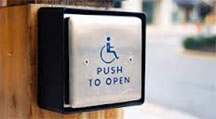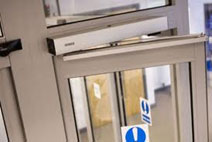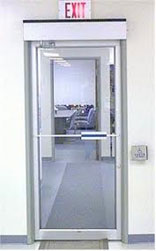Enabling Access for All Canadians
Ontario has been a leader in protecting Canadians’ equality of rights including people with disabilities. It was the first province to legislate a Human Rights Code in 1962. In 1985, the Canadian Human Rights Act became law nationwide, which prohibits discrimination based on mental or physical disability. It defines the responsibilities of organizations to improve access to places of employment, services, shops and other facilities across the country.
Persons with disabilities are both providers and receivers of services in Ontario. In their work and other activities, they use the same buildings as anyone else. It benefits your organization to ensure they have reasonable access to your facilities.
Access for Those with Walking Disabilities
 In order for disabled persons in wheelchairs or those who are ambulatory with the assistance of a cane, crutches or other mechanical assistance, guidelines exist to ensure that they are able to access buildings without undue difficulty.
In order for disabled persons in wheelchairs or those who are ambulatory with the assistance of a cane, crutches or other mechanical assistance, guidelines exist to ensure that they are able to access buildings without undue difficulty.
Properly designed and fitted doors and door hardware are key components to providing such access. Ontario building codes specify the size of doors, their hardware and operation plus the design of the entrance approaches.
Door Width
 Approaches to exterior doors that accommodate wheelchairs should be a minimum of 1.5 meters in width. At least 1.2 meters at each approach to a door opening should be level to allow maneuvering room for a wheelchair. Doors themselves should be a minimum of 80 cm in width.
Approaches to exterior doors that accommodate wheelchairs should be a minimum of 1.5 meters in width. At least 1.2 meters at each approach to a door opening should be level to allow maneuvering room for a wheelchair. Doors themselves should be a minimum of 80 cm in width.
Interior doors require either 30 cm or 60 cm of space from the latch side of the door to the wall. The amount of space depends on the direction the door swings by the person using it. Thirty cm is adequate when the door opens away from the person, but a door that opens toward the person requires 60 cm of extra space.
Door Handles
Many disabled or elderly people have difficulty grasping or twisting objects. For this reason, door handles should require only a push-pull motion or utilize a lever instead of a doorknob.
Door Closers
 The use of automatic door closers is required by fire codes in Ontario to help reduce or eliminate the spreading of smoke and fire within a building. In order to accommodate people with disabilities, such closers must not have a resistance of more than 38 Newtons so that the door is easily opened. Door closers must not close the door in less than three seconds.
The use of automatic door closers is required by fire codes in Ontario to help reduce or eliminate the spreading of smoke and fire within a building. In order to accommodate people with disabilities, such closers must not have a resistance of more than 38 Newtons so that the door is easily opened. Door closers must not close the door in less than three seconds.
Automatic Doors
Doors that open and close automatically are convenient for everyone not only the disabled. The preferred activation method for opening an automatic door is via motion detectors. However, a manual switch for opening and closing is acceptable. In this case, the switch must be operable from a wheelchair and standing position. It must require only a closed fist to operate it.
Expert Accessibility Reviews in Ontario
Our team can assist employers and property owners in evaluating potential barriers to disabled persons in their buildings. Call us today to set up an accessibility review of your property.






